Policy and Practice in the Care of Older People Name Lecturer Course Date Policy on the Relocation of the Elderly Persons into the Residential Accommodation TYPE OF DOCUMENT
VerifiedAdded on 2021/05/30
|18
|3946
|117
AI Summary
18 Policy and Practice in the Care of Older People Name Lecturer Course Date Policy on the Relocation of the Elderly Persons into the Residential Accommodation NAME OF DOCUMENT Relocation of the Elderly Persons into the Residential Accommodation NAME OF DOCUMENT Policy DOCUMENT NUMBER ------- DATE OF PUBLICATION May 17, 2018 RISK RATING Low REVIEW DATE Not Applicable FORMER REFERENCE(S) Not Applicable EXECUTIVE SPONSOR or EXECUTIVE CLINICAL SPONSOR ------------- AUTHOR ------------ KEY TERMS Elderly persons; residential accommodation; and aged
Contribute Materials
Your contribution can guide someone’s learning journey. Share your
documents today.
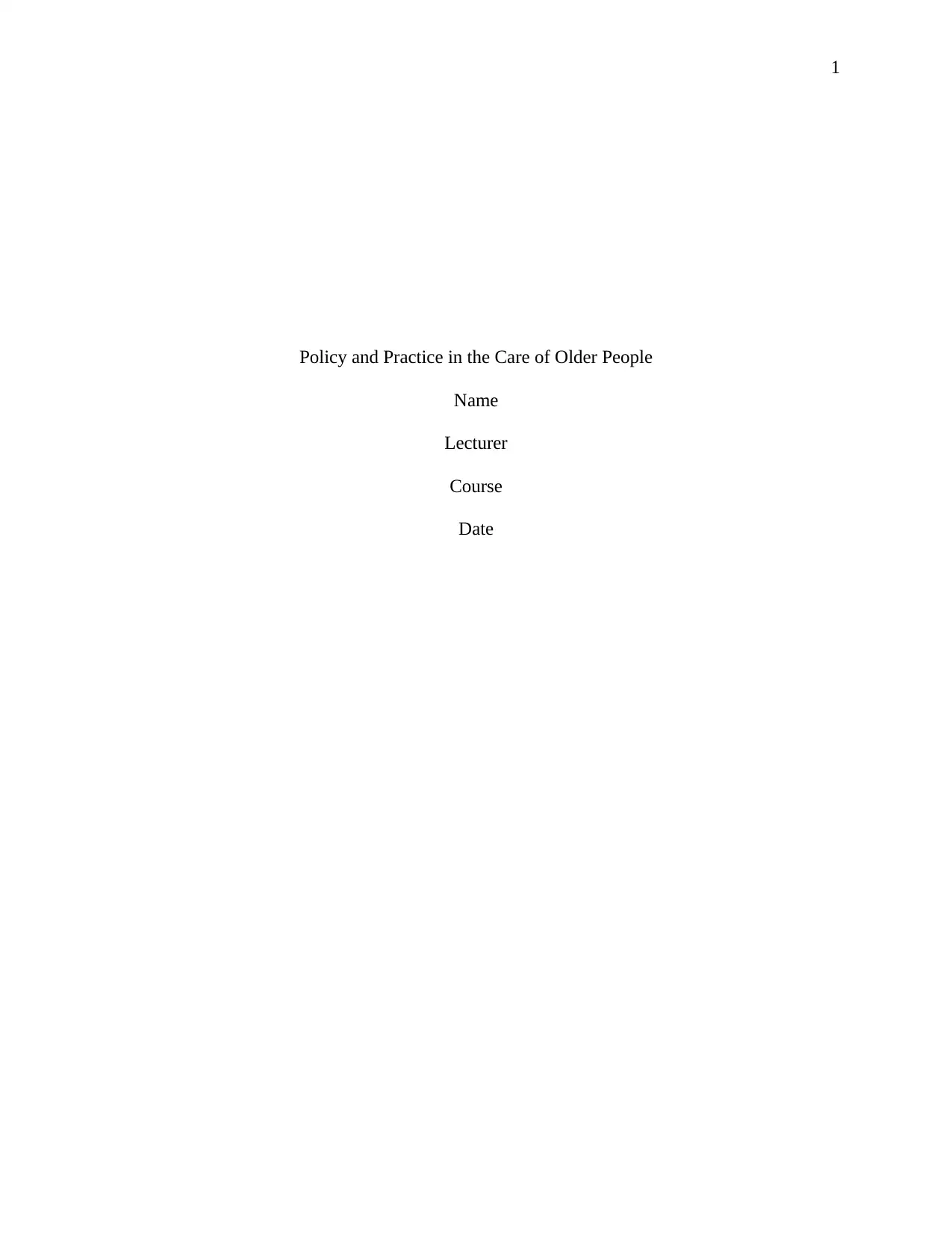
1
Policy and Practice in the Care of Older People
Name
Lecturer
Course
Date
Policy and Practice in the Care of Older People
Name
Lecturer
Course
Date
Secure Best Marks with AI Grader
Need help grading? Try our AI Grader for instant feedback on your assignments.
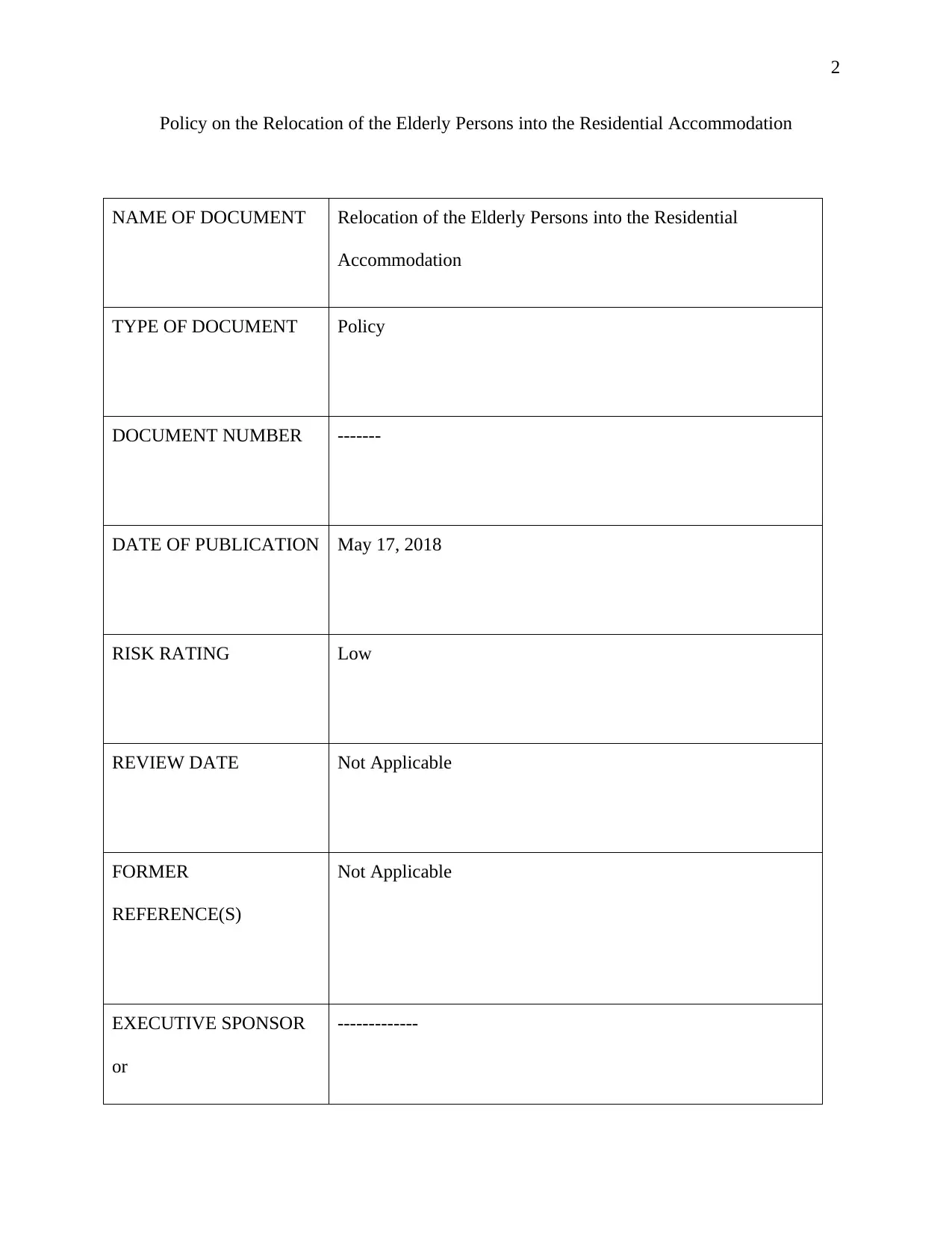
2
Policy on the Relocation of the Elderly Persons into the Residential Accommodation
NAME OF DOCUMENT Relocation of the Elderly Persons into the Residential
Accommodation
TYPE OF DOCUMENT Policy
DOCUMENT NUMBER -------
DATE OF PUBLICATION May 17, 2018
RISK RATING Low
REVIEW DATE Not Applicable
FORMER
REFERENCE(S)
Not Applicable
EXECUTIVE SPONSOR
or
-------------
Policy on the Relocation of the Elderly Persons into the Residential Accommodation
NAME OF DOCUMENT Relocation of the Elderly Persons into the Residential
Accommodation
TYPE OF DOCUMENT Policy
DOCUMENT NUMBER -------
DATE OF PUBLICATION May 17, 2018
RISK RATING Low
REVIEW DATE Not Applicable
FORMER
REFERENCE(S)
Not Applicable
EXECUTIVE SPONSOR
or
-------------
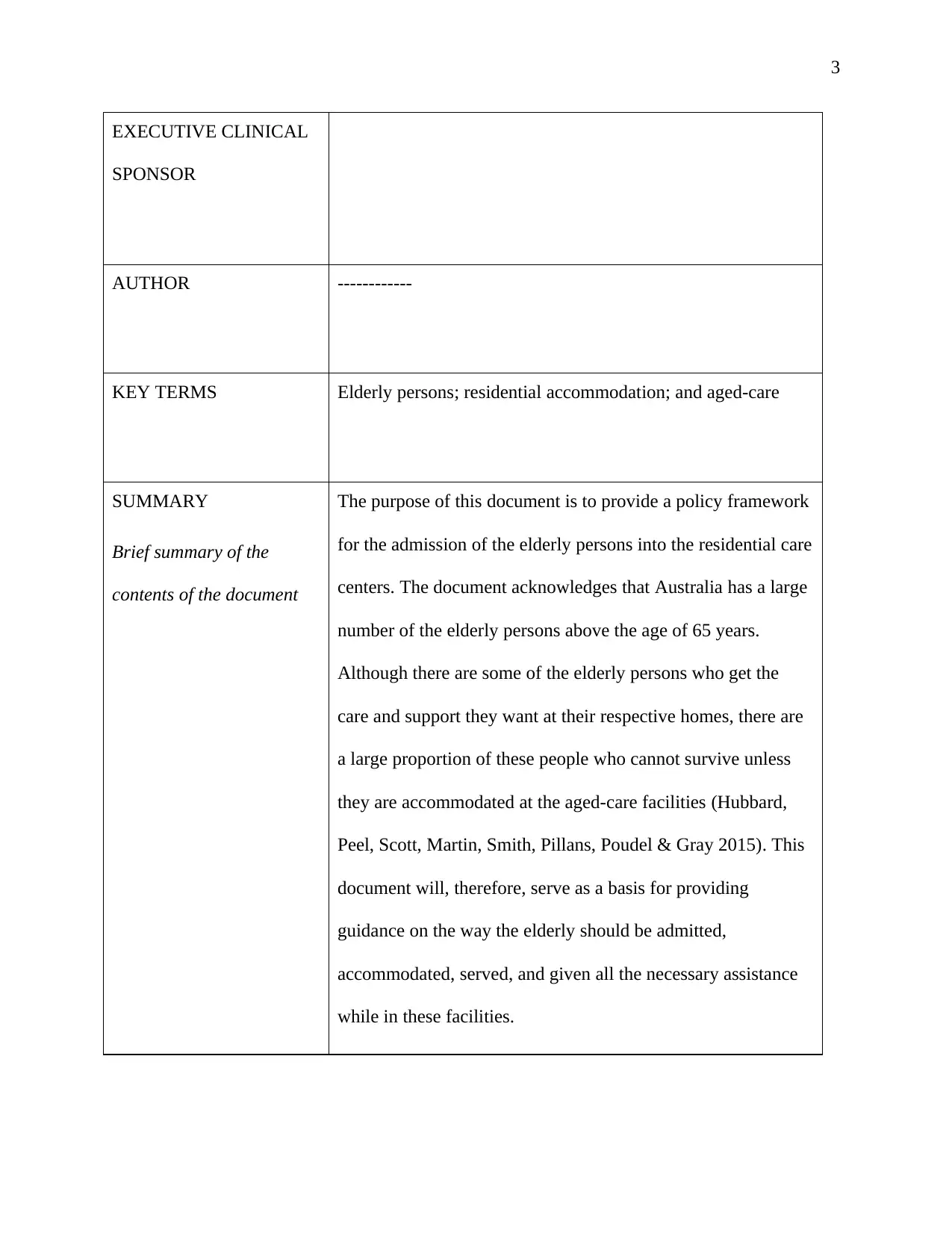
3
EXECUTIVE CLINICAL
SPONSOR
AUTHOR ------------
KEY TERMS Elderly persons; residential accommodation; and aged-care
SUMMARY
Brief summary of the
contents of the document
The purpose of this document is to provide a policy framework
for the admission of the elderly persons into the residential care
centers. The document acknowledges that Australia has a large
number of the elderly persons above the age of 65 years.
Although there are some of the elderly persons who get the
care and support they want at their respective homes, there are
a large proportion of these people who cannot survive unless
they are accommodated at the aged-care facilities (Hubbard,
Peel, Scott, Martin, Smith, Pillans, Poudel & Gray 2015). This
document will, therefore, serve as a basis for providing
guidance on the way the elderly should be admitted,
accommodated, served, and given all the necessary assistance
while in these facilities.
EXECUTIVE CLINICAL
SPONSOR
AUTHOR ------------
KEY TERMS Elderly persons; residential accommodation; and aged-care
SUMMARY
Brief summary of the
contents of the document
The purpose of this document is to provide a policy framework
for the admission of the elderly persons into the residential care
centers. The document acknowledges that Australia has a large
number of the elderly persons above the age of 65 years.
Although there are some of the elderly persons who get the
care and support they want at their respective homes, there are
a large proportion of these people who cannot survive unless
they are accommodated at the aged-care facilities (Hubbard,
Peel, Scott, Martin, Smith, Pillans, Poudel & Gray 2015). This
document will, therefore, serve as a basis for providing
guidance on the way the elderly should be admitted,
accommodated, served, and given all the necessary assistance
while in these facilities.
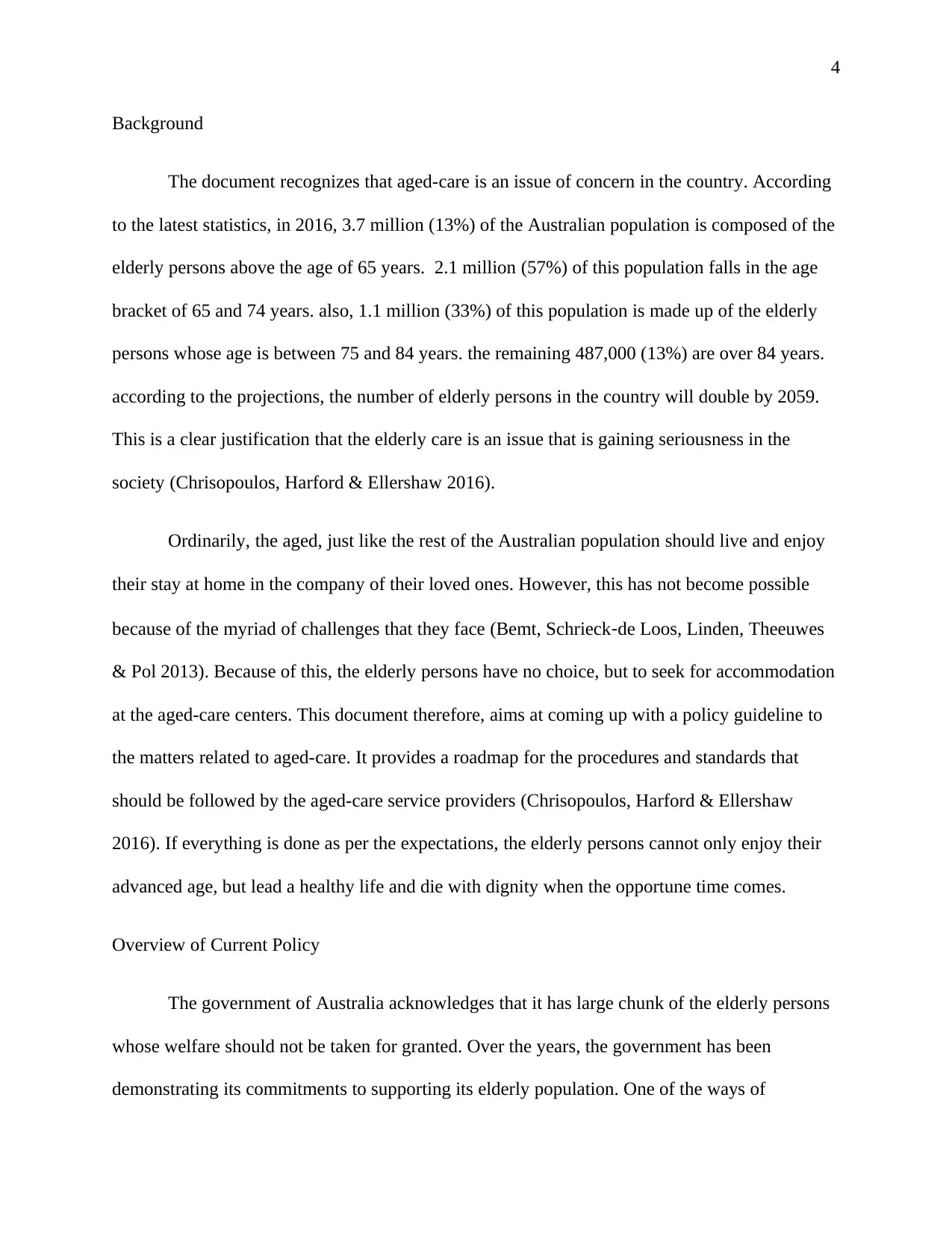
4
Background
The document recognizes that aged-care is an issue of concern in the country. According
to the latest statistics, in 2016, 3.7 million (13%) of the Australian population is composed of the
elderly persons above the age of 65 years. 2.1 million (57%) of this population falls in the age
bracket of 65 and 74 years. also, 1.1 million (33%) of this population is made up of the elderly
persons whose age is between 75 and 84 years. the remaining 487,000 (13%) are over 84 years.
according to the projections, the number of elderly persons in the country will double by 2059.
This is a clear justification that the elderly care is an issue that is gaining seriousness in the
society (Chrisopoulos, Harford & Ellershaw 2016).
Ordinarily, the aged, just like the rest of the Australian population should live and enjoy
their stay at home in the company of their loved ones. However, this has not become possible
because of the myriad of challenges that they face (Bemt, Schrieck‐de Loos, Linden, Theeuwes
& Pol 2013). Because of this, the elderly persons have no choice, but to seek for accommodation
at the aged-care centers. This document therefore, aims at coming up with a policy guideline to
the matters related to aged-care. It provides a roadmap for the procedures and standards that
should be followed by the aged-care service providers (Chrisopoulos, Harford & Ellershaw
2016). If everything is done as per the expectations, the elderly persons cannot only enjoy their
advanced age, but lead a healthy life and die with dignity when the opportune time comes.
Overview of Current Policy
The government of Australia acknowledges that it has large chunk of the elderly persons
whose welfare should not be taken for granted. Over the years, the government has been
demonstrating its commitments to supporting its elderly population. One of the ways of
Background
The document recognizes that aged-care is an issue of concern in the country. According
to the latest statistics, in 2016, 3.7 million (13%) of the Australian population is composed of the
elderly persons above the age of 65 years. 2.1 million (57%) of this population falls in the age
bracket of 65 and 74 years. also, 1.1 million (33%) of this population is made up of the elderly
persons whose age is between 75 and 84 years. the remaining 487,000 (13%) are over 84 years.
according to the projections, the number of elderly persons in the country will double by 2059.
This is a clear justification that the elderly care is an issue that is gaining seriousness in the
society (Chrisopoulos, Harford & Ellershaw 2016).
Ordinarily, the aged, just like the rest of the Australian population should live and enjoy
their stay at home in the company of their loved ones. However, this has not become possible
because of the myriad of challenges that they face (Bemt, Schrieck‐de Loos, Linden, Theeuwes
& Pol 2013). Because of this, the elderly persons have no choice, but to seek for accommodation
at the aged-care centers. This document therefore, aims at coming up with a policy guideline to
the matters related to aged-care. It provides a roadmap for the procedures and standards that
should be followed by the aged-care service providers (Chrisopoulos, Harford & Ellershaw
2016). If everything is done as per the expectations, the elderly persons cannot only enjoy their
advanced age, but lead a healthy life and die with dignity when the opportune time comes.
Overview of Current Policy
The government of Australia acknowledges that it has large chunk of the elderly persons
whose welfare should not be taken for granted. Over the years, the government has been
demonstrating its commitments to supporting its elderly population. One of the ways of
Secure Best Marks with AI Grader
Need help grading? Try our AI Grader for instant feedback on your assignments.
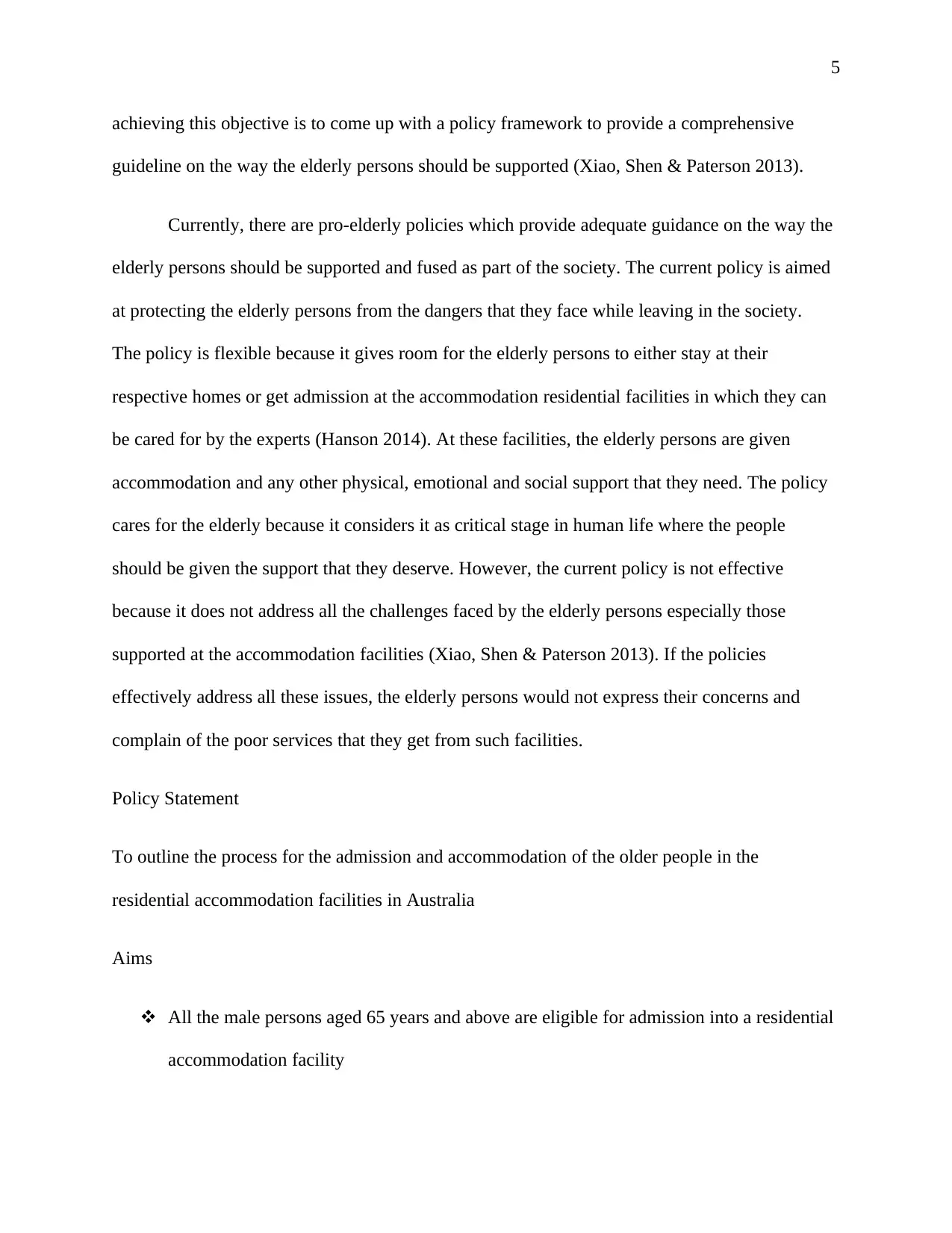
5
achieving this objective is to come up with a policy framework to provide a comprehensive
guideline on the way the elderly persons should be supported (Xiao, Shen & Paterson 2013).
Currently, there are pro-elderly policies which provide adequate guidance on the way the
elderly persons should be supported and fused as part of the society. The current policy is aimed
at protecting the elderly persons from the dangers that they face while leaving in the society.
The policy is flexible because it gives room for the elderly persons to either stay at their
respective homes or get admission at the accommodation residential facilities in which they can
be cared for by the experts (Hanson 2014). At these facilities, the elderly persons are given
accommodation and any other physical, emotional and social support that they need. The policy
cares for the elderly because it considers it as critical stage in human life where the people
should be given the support that they deserve. However, the current policy is not effective
because it does not address all the challenges faced by the elderly persons especially those
supported at the accommodation facilities (Xiao, Shen & Paterson 2013). If the policies
effectively address all these issues, the elderly persons would not express their concerns and
complain of the poor services that they get from such facilities.
Policy Statement
To outline the process for the admission and accommodation of the older people in the
residential accommodation facilities in Australia
Aims
All the male persons aged 65 years and above are eligible for admission into a residential
accommodation facility
achieving this objective is to come up with a policy framework to provide a comprehensive
guideline on the way the elderly persons should be supported (Xiao, Shen & Paterson 2013).
Currently, there are pro-elderly policies which provide adequate guidance on the way the
elderly persons should be supported and fused as part of the society. The current policy is aimed
at protecting the elderly persons from the dangers that they face while leaving in the society.
The policy is flexible because it gives room for the elderly persons to either stay at their
respective homes or get admission at the accommodation residential facilities in which they can
be cared for by the experts (Hanson 2014). At these facilities, the elderly persons are given
accommodation and any other physical, emotional and social support that they need. The policy
cares for the elderly because it considers it as critical stage in human life where the people
should be given the support that they deserve. However, the current policy is not effective
because it does not address all the challenges faced by the elderly persons especially those
supported at the accommodation facilities (Xiao, Shen & Paterson 2013). If the policies
effectively address all these issues, the elderly persons would not express their concerns and
complain of the poor services that they get from such facilities.
Policy Statement
To outline the process for the admission and accommodation of the older people in the
residential accommodation facilities in Australia
Aims
All the male persons aged 65 years and above are eligible for admission into a residential
accommodation facility
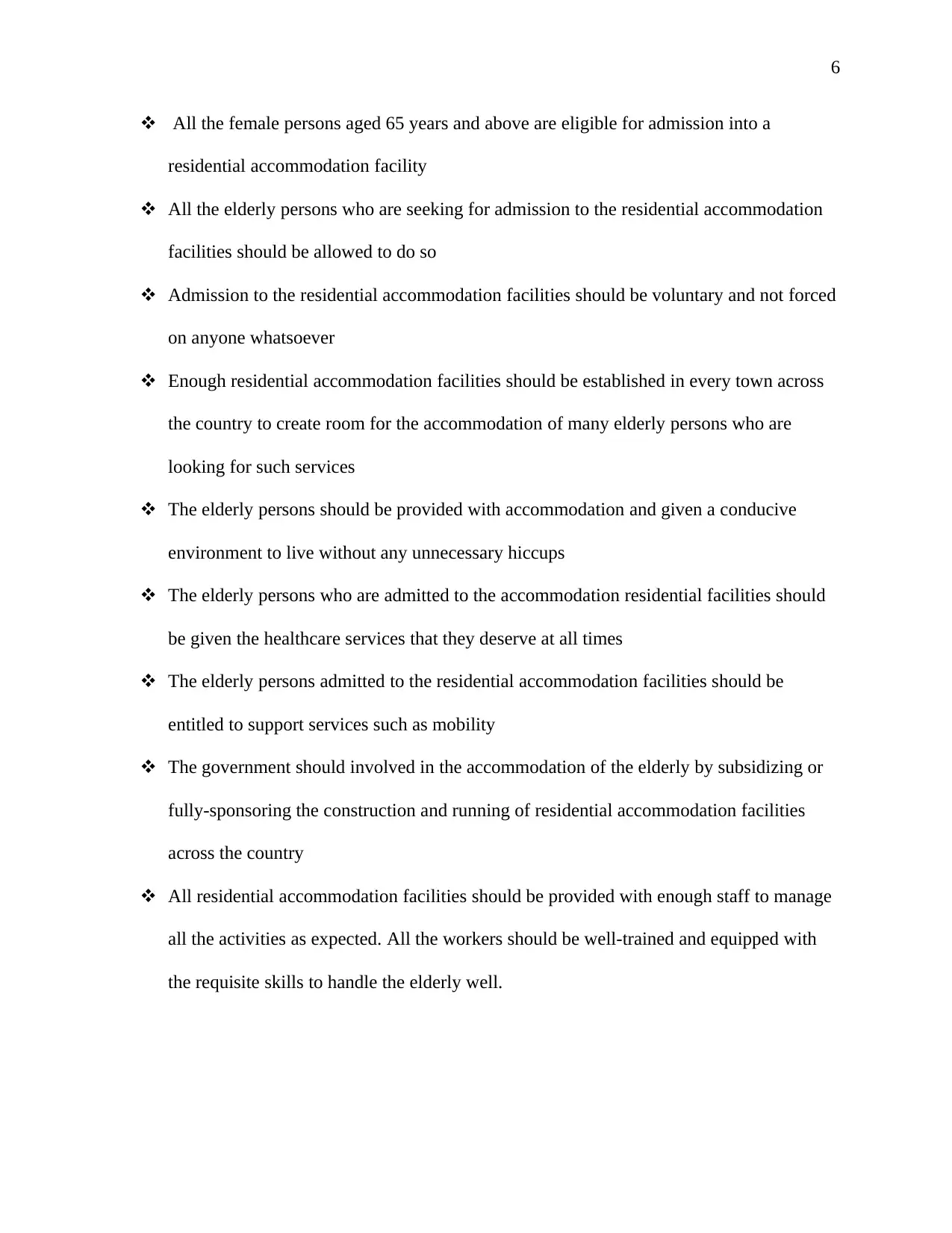
6
All the female persons aged 65 years and above are eligible for admission into a
residential accommodation facility
All the elderly persons who are seeking for admission to the residential accommodation
facilities should be allowed to do so
Admission to the residential accommodation facilities should be voluntary and not forced
on anyone whatsoever
Enough residential accommodation facilities should be established in every town across
the country to create room for the accommodation of many elderly persons who are
looking for such services
The elderly persons should be provided with accommodation and given a conducive
environment to live without any unnecessary hiccups
The elderly persons who are admitted to the accommodation residential facilities should
be given the healthcare services that they deserve at all times
The elderly persons admitted to the residential accommodation facilities should be
entitled to support services such as mobility
The government should involved in the accommodation of the elderly by subsidizing or
fully-sponsoring the construction and running of residential accommodation facilities
across the country
All residential accommodation facilities should be provided with enough staff to manage
all the activities as expected. All the workers should be well-trained and equipped with
the requisite skills to handle the elderly well.
All the female persons aged 65 years and above are eligible for admission into a
residential accommodation facility
All the elderly persons who are seeking for admission to the residential accommodation
facilities should be allowed to do so
Admission to the residential accommodation facilities should be voluntary and not forced
on anyone whatsoever
Enough residential accommodation facilities should be established in every town across
the country to create room for the accommodation of many elderly persons who are
looking for such services
The elderly persons should be provided with accommodation and given a conducive
environment to live without any unnecessary hiccups
The elderly persons who are admitted to the accommodation residential facilities should
be given the healthcare services that they deserve at all times
The elderly persons admitted to the residential accommodation facilities should be
entitled to support services such as mobility
The government should involved in the accommodation of the elderly by subsidizing or
fully-sponsoring the construction and running of residential accommodation facilities
across the country
All residential accommodation facilities should be provided with enough staff to manage
all the activities as expected. All the workers should be well-trained and equipped with
the requisite skills to handle the elderly well.
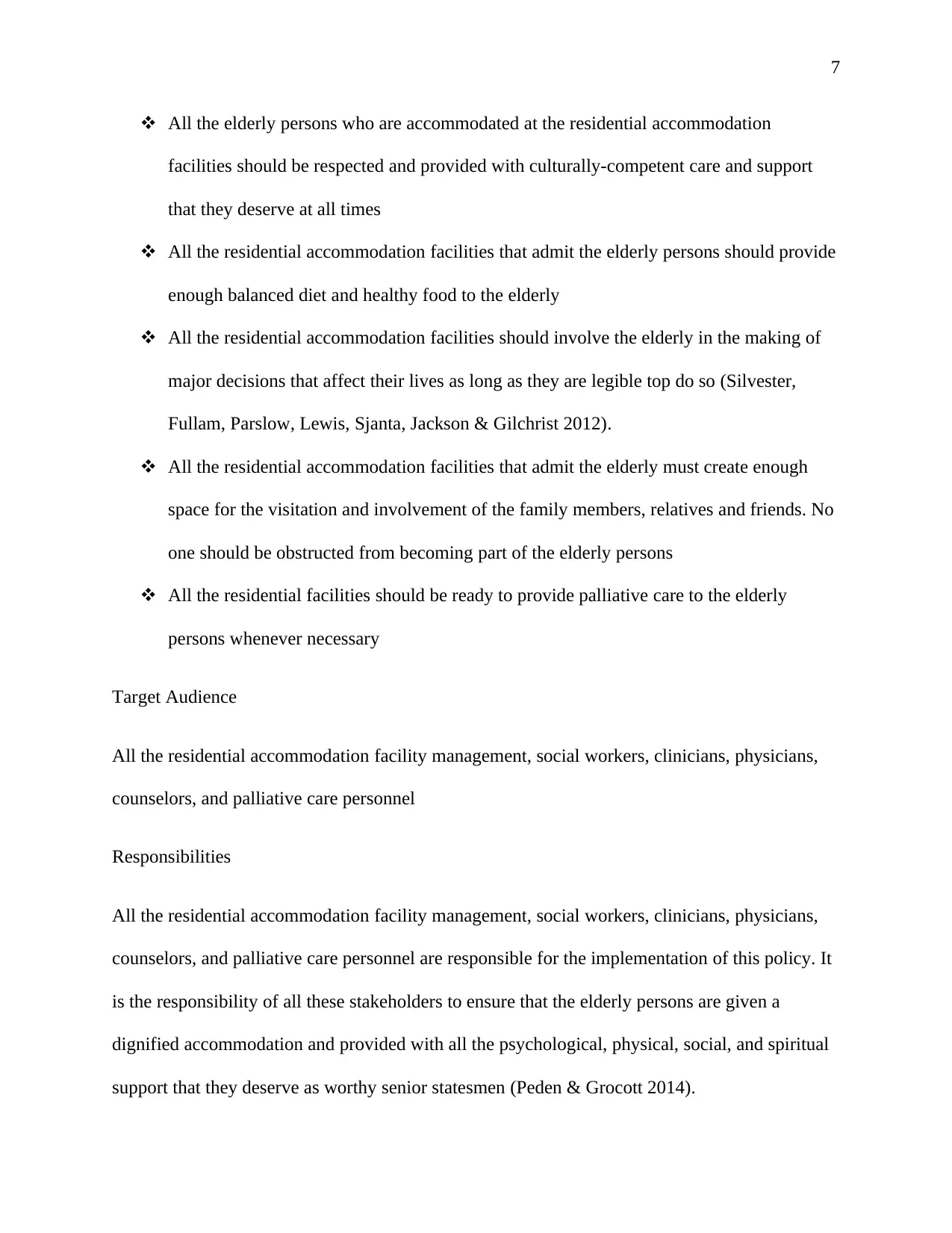
7
All the elderly persons who are accommodated at the residential accommodation
facilities should be respected and provided with culturally-competent care and support
that they deserve at all times
All the residential accommodation facilities that admit the elderly persons should provide
enough balanced diet and healthy food to the elderly
All the residential accommodation facilities should involve the elderly in the making of
major decisions that affect their lives as long as they are legible top do so (Silvester,
Fullam, Parslow, Lewis, Sjanta, Jackson & Gilchrist 2012).
All the residential accommodation facilities that admit the elderly must create enough
space for the visitation and involvement of the family members, relatives and friends. No
one should be obstructed from becoming part of the elderly persons
All the residential facilities should be ready to provide palliative care to the elderly
persons whenever necessary
Target Audience
All the residential accommodation facility management, social workers, clinicians, physicians,
counselors, and palliative care personnel
Responsibilities
All the residential accommodation facility management, social workers, clinicians, physicians,
counselors, and palliative care personnel are responsible for the implementation of this policy. It
is the responsibility of all these stakeholders to ensure that the elderly persons are given a
dignified accommodation and provided with all the psychological, physical, social, and spiritual
support that they deserve as worthy senior statesmen (Peden & Grocott 2014).
All the elderly persons who are accommodated at the residential accommodation
facilities should be respected and provided with culturally-competent care and support
that they deserve at all times
All the residential accommodation facilities that admit the elderly persons should provide
enough balanced diet and healthy food to the elderly
All the residential accommodation facilities should involve the elderly in the making of
major decisions that affect their lives as long as they are legible top do so (Silvester,
Fullam, Parslow, Lewis, Sjanta, Jackson & Gilchrist 2012).
All the residential accommodation facilities that admit the elderly must create enough
space for the visitation and involvement of the family members, relatives and friends. No
one should be obstructed from becoming part of the elderly persons
All the residential facilities should be ready to provide palliative care to the elderly
persons whenever necessary
Target Audience
All the residential accommodation facility management, social workers, clinicians, physicians,
counselors, and palliative care personnel
Responsibilities
All the residential accommodation facility management, social workers, clinicians, physicians,
counselors, and palliative care personnel are responsible for the implementation of this policy. It
is the responsibility of all these stakeholders to ensure that the elderly persons are given a
dignified accommodation and provided with all the psychological, physical, social, and spiritual
support that they deserve as worthy senior statesmen (Peden & Grocott 2014).
Paraphrase This Document
Need a fresh take? Get an instant paraphrase of this document with our AI Paraphraser
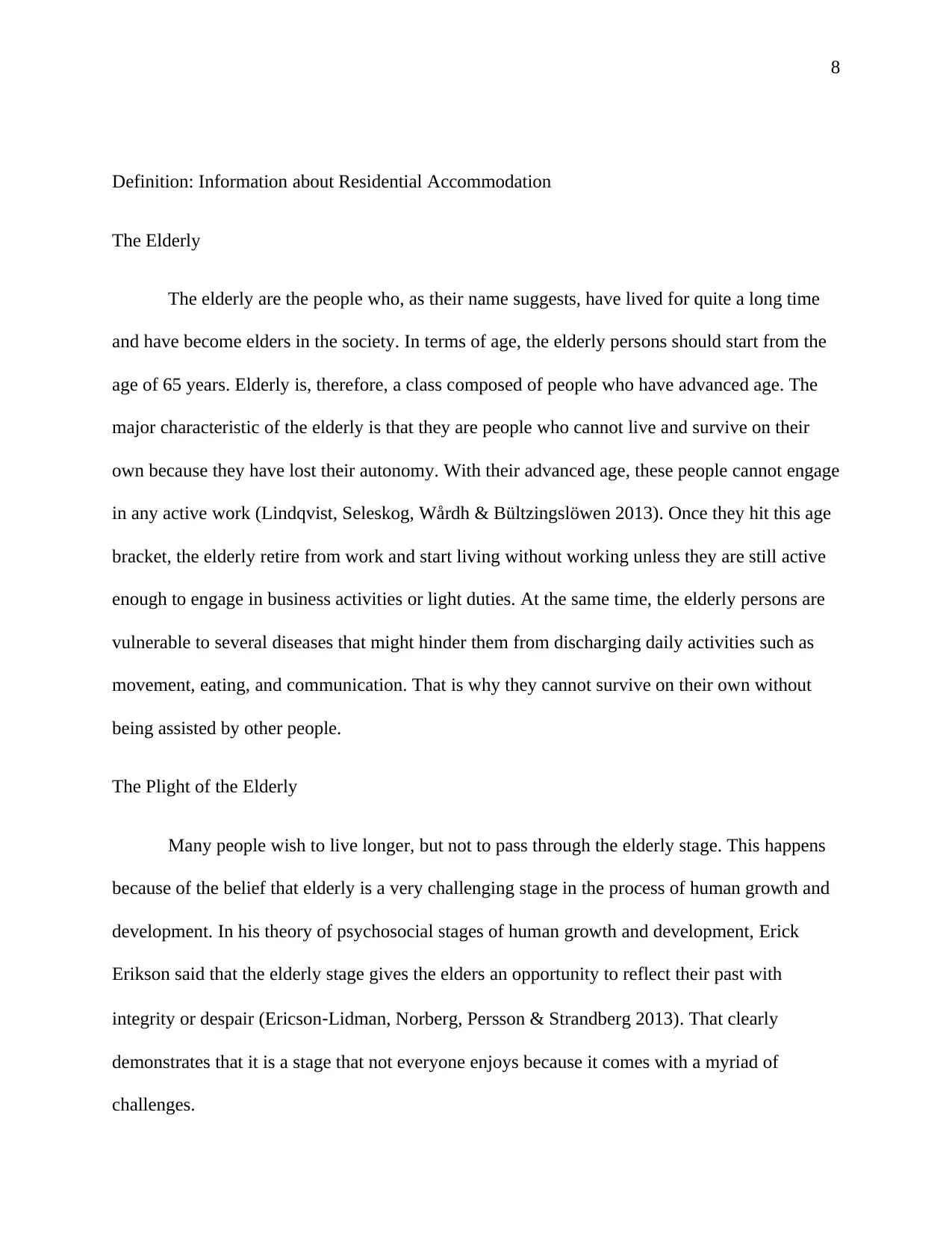
8
Definition: Information about Residential Accommodation
The Elderly
The elderly are the people who, as their name suggests, have lived for quite a long time
and have become elders in the society. In terms of age, the elderly persons should start from the
age of 65 years. Elderly is, therefore, a class composed of people who have advanced age. The
major characteristic of the elderly is that they are people who cannot live and survive on their
own because they have lost their autonomy. With their advanced age, these people cannot engage
in any active work (Lindqvist, Seleskog, Wårdh & Bültzingslöwen 2013). Once they hit this age
bracket, the elderly retire from work and start living without working unless they are still active
enough to engage in business activities or light duties. At the same time, the elderly persons are
vulnerable to several diseases that might hinder them from discharging daily activities such as
movement, eating, and communication. That is why they cannot survive on their own without
being assisted by other people.
The Plight of the Elderly
Many people wish to live longer, but not to pass through the elderly stage. This happens
because of the belief that elderly is a very challenging stage in the process of human growth and
development. In his theory of psychosocial stages of human growth and development, Erick
Erikson said that the elderly stage gives the elders an opportunity to reflect their past with
integrity or despair (Ericson‐Lidman, Norberg, Persson & Strandberg 2013). That clearly
demonstrates that it is a stage that not everyone enjoys because it comes with a myriad of
challenges.
Definition: Information about Residential Accommodation
The Elderly
The elderly are the people who, as their name suggests, have lived for quite a long time
and have become elders in the society. In terms of age, the elderly persons should start from the
age of 65 years. Elderly is, therefore, a class composed of people who have advanced age. The
major characteristic of the elderly is that they are people who cannot live and survive on their
own because they have lost their autonomy. With their advanced age, these people cannot engage
in any active work (Lindqvist, Seleskog, Wårdh & Bültzingslöwen 2013). Once they hit this age
bracket, the elderly retire from work and start living without working unless they are still active
enough to engage in business activities or light duties. At the same time, the elderly persons are
vulnerable to several diseases that might hinder them from discharging daily activities such as
movement, eating, and communication. That is why they cannot survive on their own without
being assisted by other people.
The Plight of the Elderly
Many people wish to live longer, but not to pass through the elderly stage. This happens
because of the belief that elderly is a very challenging stage in the process of human growth and
development. In his theory of psychosocial stages of human growth and development, Erick
Erikson said that the elderly stage gives the elders an opportunity to reflect their past with
integrity or despair (Ericson‐Lidman, Norberg, Persson & Strandberg 2013). That clearly
demonstrates that it is a stage that not everyone enjoys because it comes with a myriad of
challenges.
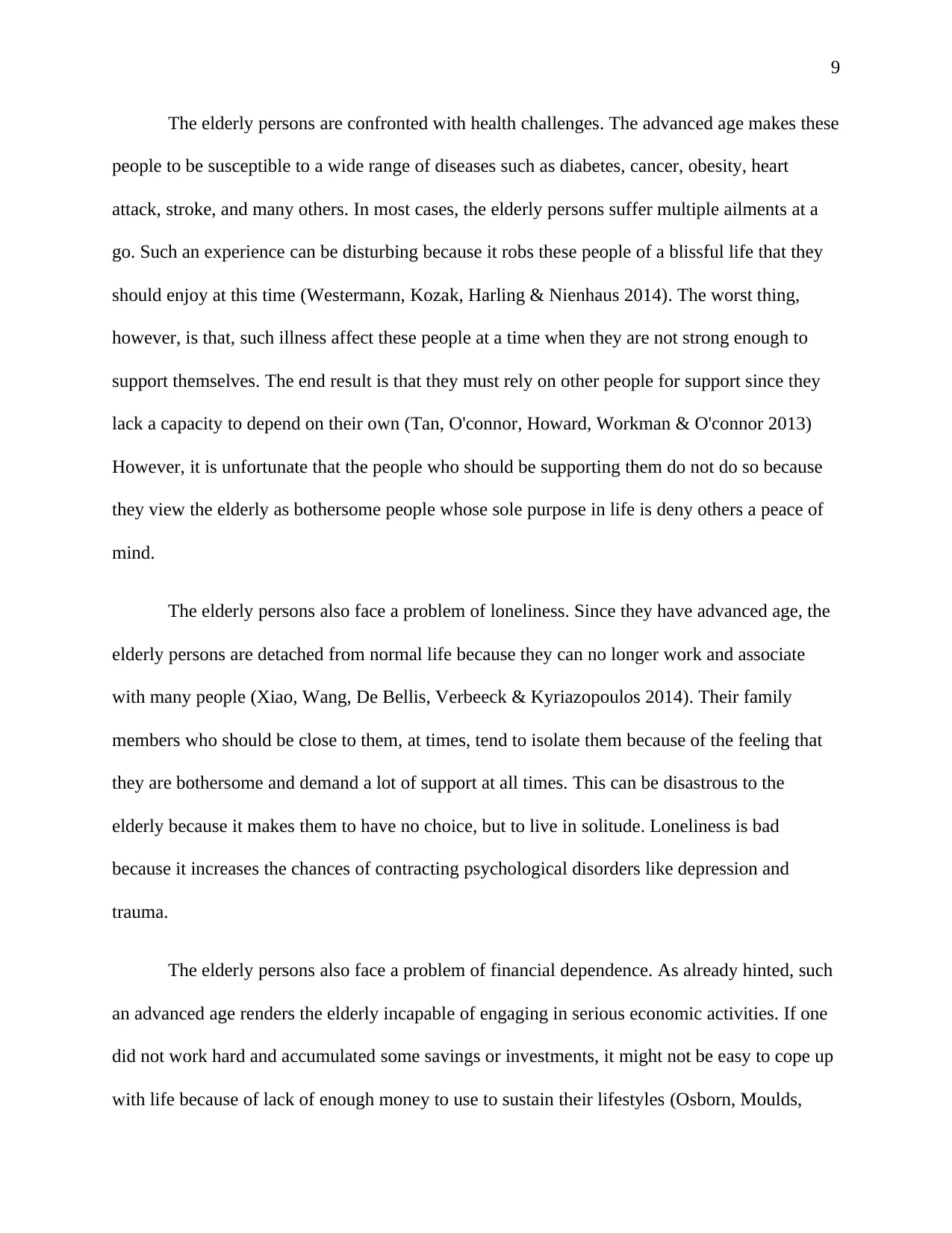
9
The elderly persons are confronted with health challenges. The advanced age makes these
people to be susceptible to a wide range of diseases such as diabetes, cancer, obesity, heart
attack, stroke, and many others. In most cases, the elderly persons suffer multiple ailments at a
go. Such an experience can be disturbing because it robs these people of a blissful life that they
should enjoy at this time (Westermann, Kozak, Harling & Nienhaus 2014). The worst thing,
however, is that, such illness affect these people at a time when they are not strong enough to
support themselves. The end result is that they must rely on other people for support since they
lack a capacity to depend on their own (Tan, O'connor, Howard, Workman & O'connor 2013)
However, it is unfortunate that the people who should be supporting them do not do so because
they view the elderly as bothersome people whose sole purpose in life is deny others a peace of
mind.
The elderly persons also face a problem of loneliness. Since they have advanced age, the
elderly persons are detached from normal life because they can no longer work and associate
with many people (Xiao, Wang, De Bellis, Verbeeck & Kyriazopoulos 2014). Their family
members who should be close to them, at times, tend to isolate them because of the feeling that
they are bothersome and demand a lot of support at all times. This can be disastrous to the
elderly because it makes them to have no choice, but to live in solitude. Loneliness is bad
because it increases the chances of contracting psychological disorders like depression and
trauma.
The elderly persons also face a problem of financial dependence. As already hinted, such
an advanced age renders the elderly incapable of engaging in serious economic activities. If one
did not work hard and accumulated some savings or investments, it might not be easy to cope up
with life because of lack of enough money to use to sustain their lifestyles (Osborn, Moulds,
The elderly persons are confronted with health challenges. The advanced age makes these
people to be susceptible to a wide range of diseases such as diabetes, cancer, obesity, heart
attack, stroke, and many others. In most cases, the elderly persons suffer multiple ailments at a
go. Such an experience can be disturbing because it robs these people of a blissful life that they
should enjoy at this time (Westermann, Kozak, Harling & Nienhaus 2014). The worst thing,
however, is that, such illness affect these people at a time when they are not strong enough to
support themselves. The end result is that they must rely on other people for support since they
lack a capacity to depend on their own (Tan, O'connor, Howard, Workman & O'connor 2013)
However, it is unfortunate that the people who should be supporting them do not do so because
they view the elderly as bothersome people whose sole purpose in life is deny others a peace of
mind.
The elderly persons also face a problem of loneliness. Since they have advanced age, the
elderly persons are detached from normal life because they can no longer work and associate
with many people (Xiao, Wang, De Bellis, Verbeeck & Kyriazopoulos 2014). Their family
members who should be close to them, at times, tend to isolate them because of the feeling that
they are bothersome and demand a lot of support at all times. This can be disastrous to the
elderly because it makes them to have no choice, but to live in solitude. Loneliness is bad
because it increases the chances of contracting psychological disorders like depression and
trauma.
The elderly persons also face a problem of financial dependence. As already hinted, such
an advanced age renders the elderly incapable of engaging in serious economic activities. If one
did not work hard and accumulated some savings or investments, it might not be easy to cope up
with life because of lack of enough money to use to sustain their lifestyles (Osborn, Moulds,
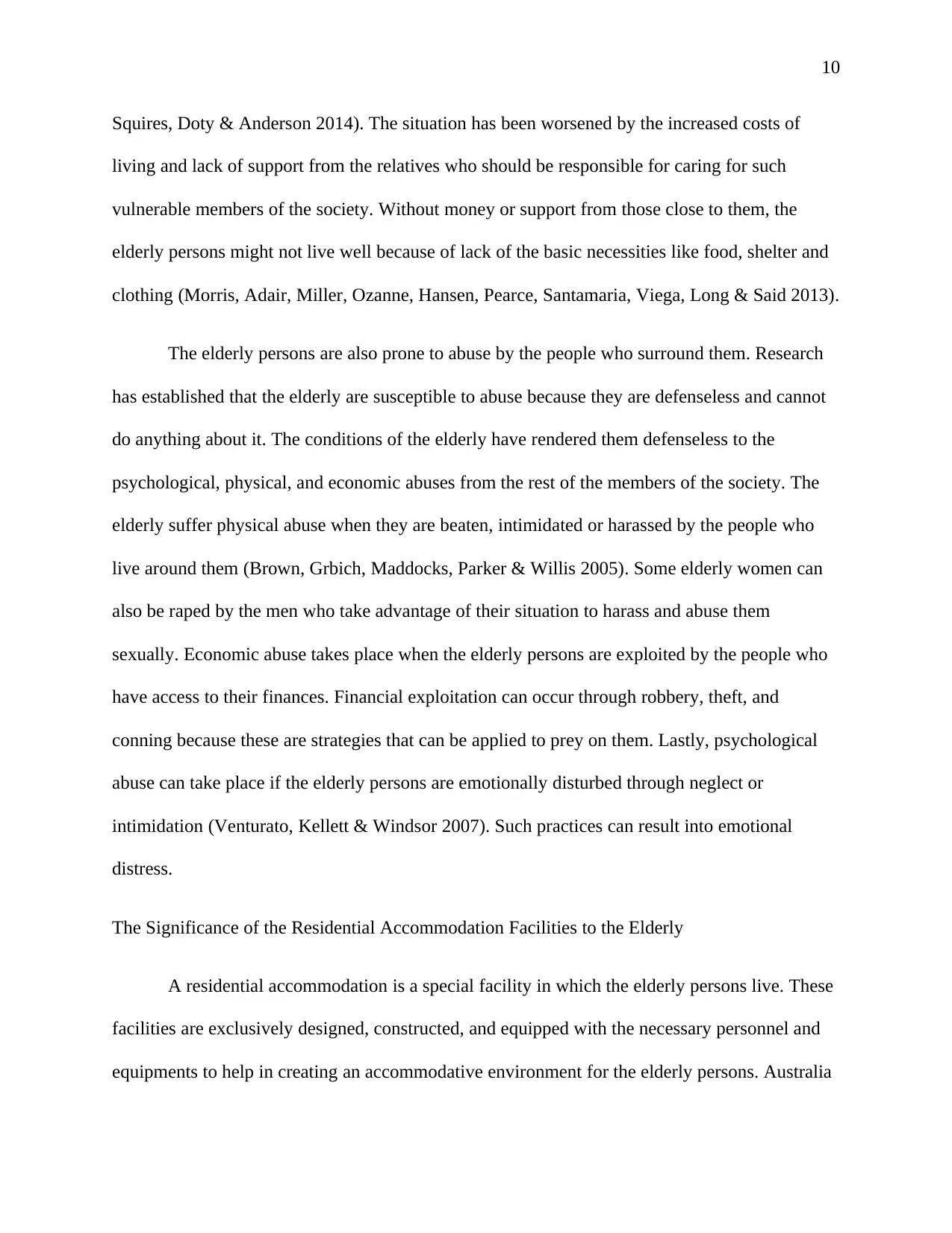
10
Squires, Doty & Anderson 2014). The situation has been worsened by the increased costs of
living and lack of support from the relatives who should be responsible for caring for such
vulnerable members of the society. Without money or support from those close to them, the
elderly persons might not live well because of lack of the basic necessities like food, shelter and
clothing (Morris, Adair, Miller, Ozanne, Hansen, Pearce, Santamaria, Viega, Long & Said 2013).
The elderly persons are also prone to abuse by the people who surround them. Research
has established that the elderly are susceptible to abuse because they are defenseless and cannot
do anything about it. The conditions of the elderly have rendered them defenseless to the
psychological, physical, and economic abuses from the rest of the members of the society. The
elderly suffer physical abuse when they are beaten, intimidated or harassed by the people who
live around them (Brown, Grbich, Maddocks, Parker & Willis 2005). Some elderly women can
also be raped by the men who take advantage of their situation to harass and abuse them
sexually. Economic abuse takes place when the elderly persons are exploited by the people who
have access to their finances. Financial exploitation can occur through robbery, theft, and
conning because these are strategies that can be applied to prey on them. Lastly, psychological
abuse can take place if the elderly persons are emotionally disturbed through neglect or
intimidation (Venturato, Kellett & Windsor 2007). Such practices can result into emotional
distress.
The Significance of the Residential Accommodation Facilities to the Elderly
A residential accommodation is a special facility in which the elderly persons live. These
facilities are exclusively designed, constructed, and equipped with the necessary personnel and
equipments to help in creating an accommodative environment for the elderly persons. Australia
Squires, Doty & Anderson 2014). The situation has been worsened by the increased costs of
living and lack of support from the relatives who should be responsible for caring for such
vulnerable members of the society. Without money or support from those close to them, the
elderly persons might not live well because of lack of the basic necessities like food, shelter and
clothing (Morris, Adair, Miller, Ozanne, Hansen, Pearce, Santamaria, Viega, Long & Said 2013).
The elderly persons are also prone to abuse by the people who surround them. Research
has established that the elderly are susceptible to abuse because they are defenseless and cannot
do anything about it. The conditions of the elderly have rendered them defenseless to the
psychological, physical, and economic abuses from the rest of the members of the society. The
elderly suffer physical abuse when they are beaten, intimidated or harassed by the people who
live around them (Brown, Grbich, Maddocks, Parker & Willis 2005). Some elderly women can
also be raped by the men who take advantage of their situation to harass and abuse them
sexually. Economic abuse takes place when the elderly persons are exploited by the people who
have access to their finances. Financial exploitation can occur through robbery, theft, and
conning because these are strategies that can be applied to prey on them. Lastly, psychological
abuse can take place if the elderly persons are emotionally disturbed through neglect or
intimidation (Venturato, Kellett & Windsor 2007). Such practices can result into emotional
distress.
The Significance of the Residential Accommodation Facilities to the Elderly
A residential accommodation is a special facility in which the elderly persons live. These
facilities are exclusively designed, constructed, and equipped with the necessary personnel and
equipments to help in creating an accommodative environment for the elderly persons. Australia
Secure Best Marks with AI Grader
Need help grading? Try our AI Grader for instant feedback on your assignments.
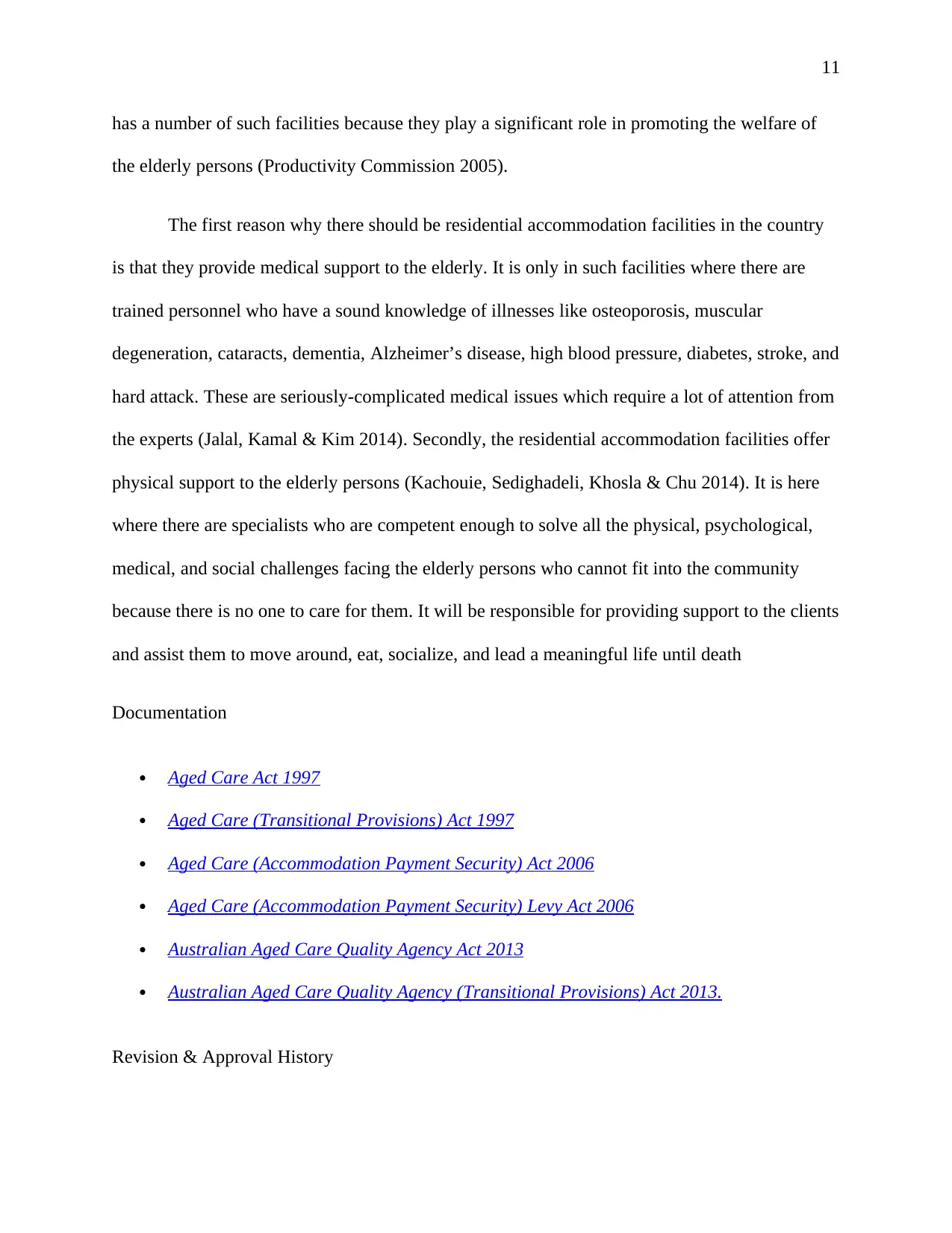
11
has a number of such facilities because they play a significant role in promoting the welfare of
the elderly persons (Productivity Commission 2005).
The first reason why there should be residential accommodation facilities in the country
is that they provide medical support to the elderly. It is only in such facilities where there are
trained personnel who have a sound knowledge of illnesses like osteoporosis, muscular
degeneration, cataracts, dementia, Alzheimer’s disease, high blood pressure, diabetes, stroke, and
hard attack. These are seriously-complicated medical issues which require a lot of attention from
the experts (Jalal, Kamal & Kim 2014). Secondly, the residential accommodation facilities offer
physical support to the elderly persons (Kachouie, Sedighadeli, Khosla & Chu 2014). It is here
where there are specialists who are competent enough to solve all the physical, psychological,
medical, and social challenges facing the elderly persons who cannot fit into the community
because there is no one to care for them. It will be responsible for providing support to the clients
and assist them to move around, eat, socialize, and lead a meaningful life until death
Documentation
Aged Care Act 1997
Aged Care (Transitional Provisions) Act 1997
Aged Care (Accommodation Payment Security) Act 2006
Aged Care (Accommodation Payment Security) Levy Act 2006
Australian Aged Care Quality Agency Act 2013
Australian Aged Care Quality Agency (Transitional Provisions) Act 2013.
Revision & Approval History
has a number of such facilities because they play a significant role in promoting the welfare of
the elderly persons (Productivity Commission 2005).
The first reason why there should be residential accommodation facilities in the country
is that they provide medical support to the elderly. It is only in such facilities where there are
trained personnel who have a sound knowledge of illnesses like osteoporosis, muscular
degeneration, cataracts, dementia, Alzheimer’s disease, high blood pressure, diabetes, stroke, and
hard attack. These are seriously-complicated medical issues which require a lot of attention from
the experts (Jalal, Kamal & Kim 2014). Secondly, the residential accommodation facilities offer
physical support to the elderly persons (Kachouie, Sedighadeli, Khosla & Chu 2014). It is here
where there are specialists who are competent enough to solve all the physical, psychological,
medical, and social challenges facing the elderly persons who cannot fit into the community
because there is no one to care for them. It will be responsible for providing support to the clients
and assist them to move around, eat, socialize, and lead a meaningful life until death
Documentation
Aged Care Act 1997
Aged Care (Transitional Provisions) Act 1997
Aged Care (Accommodation Payment Security) Act 2006
Aged Care (Accommodation Payment Security) Levy Act 2006
Australian Aged Care Quality Agency Act 2013
Australian Aged Care Quality Agency (Transitional Provisions) Act 2013.
Revision & Approval History
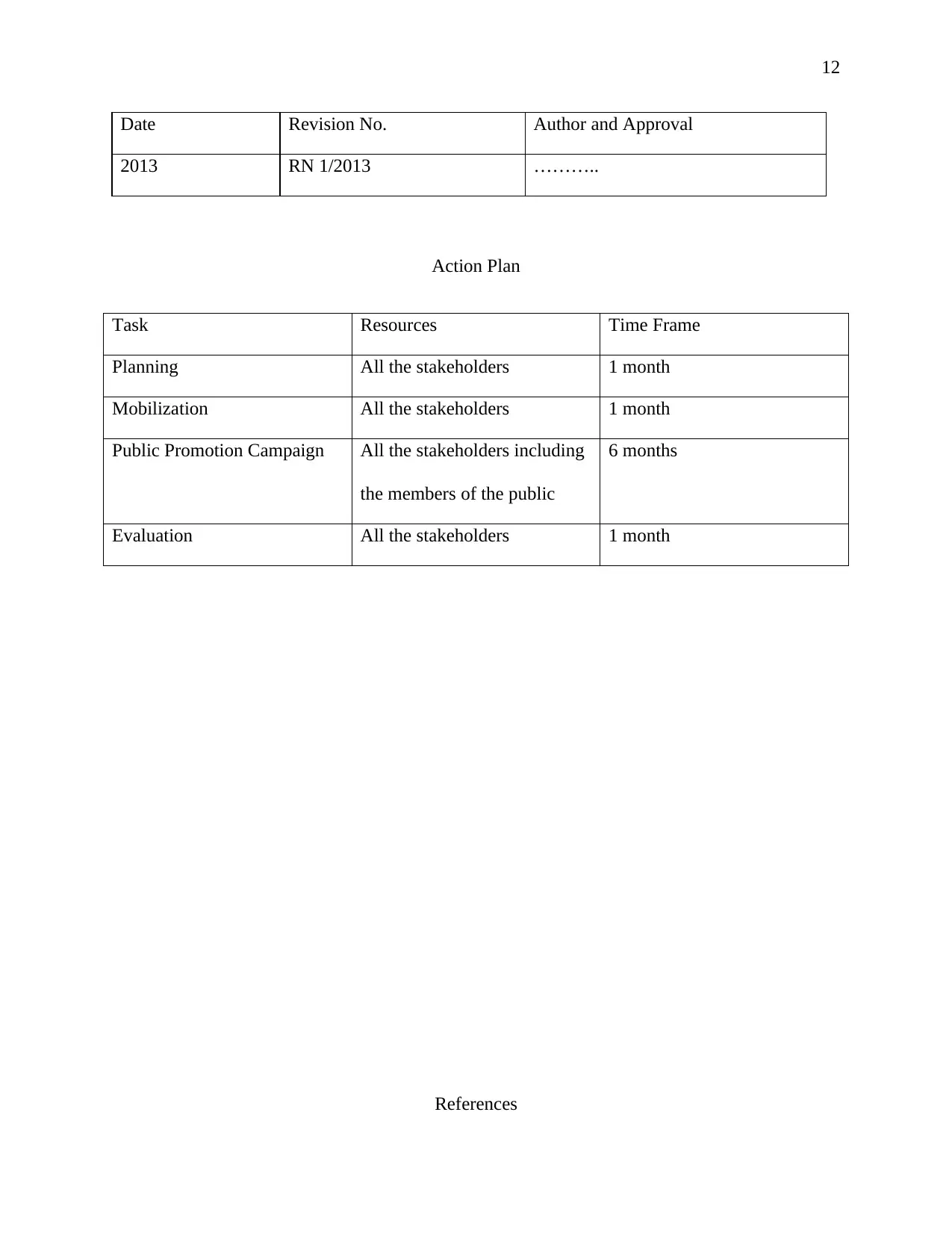
12
Date Revision No. Author and Approval
2013 RN 1/2013 ………..
Action Plan
Task Resources Time Frame
Planning All the stakeholders 1 month
Mobilization All the stakeholders 1 month
Public Promotion Campaign All the stakeholders including
the members of the public
6 months
Evaluation All the stakeholders 1 month
References
Date Revision No. Author and Approval
2013 RN 1/2013 ………..
Action Plan
Task Resources Time Frame
Planning All the stakeholders 1 month
Mobilization All the stakeholders 1 month
Public Promotion Campaign All the stakeholders including
the members of the public
6 months
Evaluation All the stakeholders 1 month
References
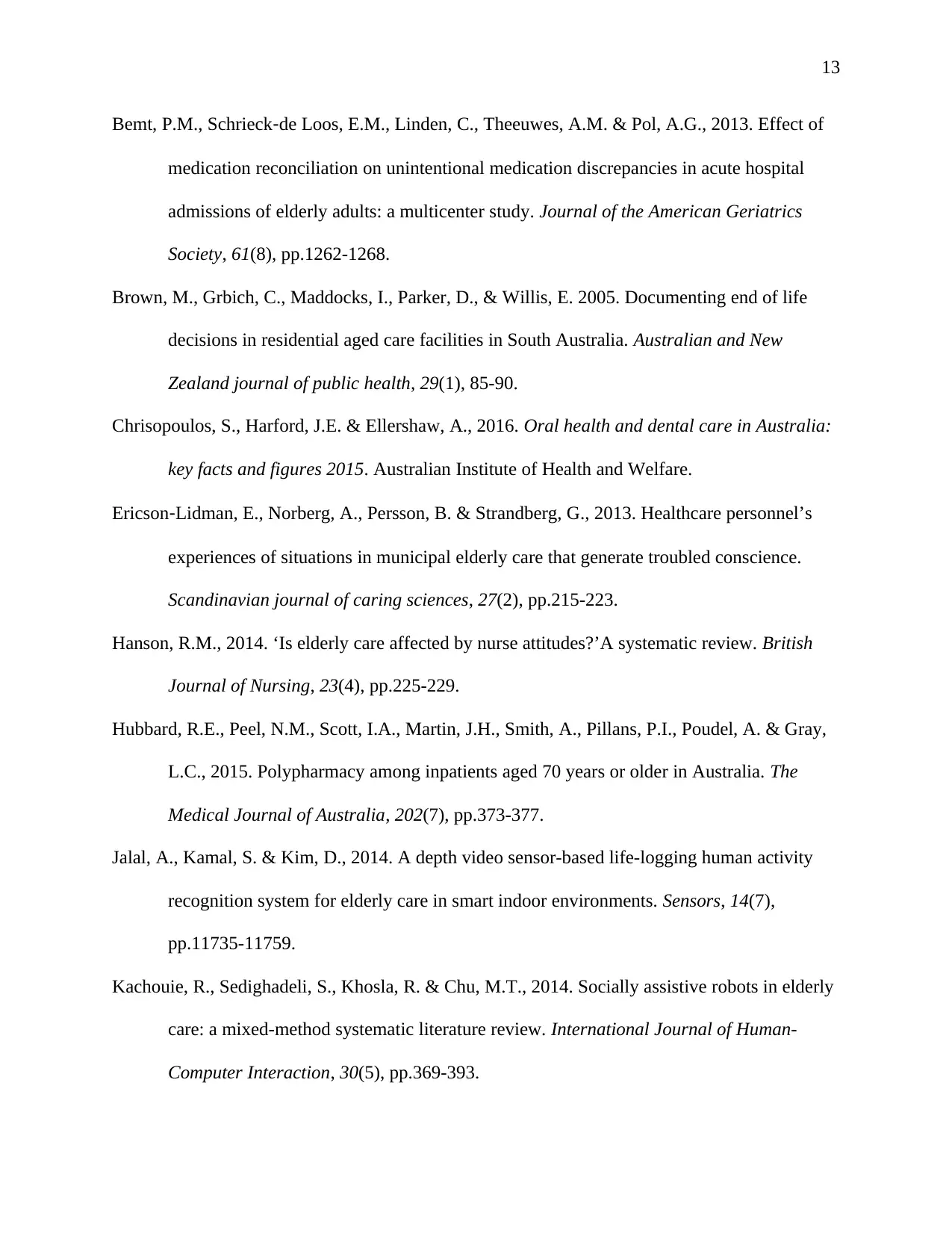
13
Bemt, P.M., Schrieck‐de Loos, E.M., Linden, C., Theeuwes, A.M. & Pol, A.G., 2013. Effect of
medication reconciliation on unintentional medication discrepancies in acute hospital
admissions of elderly adults: a multicenter study. Journal of the American Geriatrics
Society, 61(8), pp.1262-1268.
Brown, M., Grbich, C., Maddocks, I., Parker, D., & Willis, E. 2005. Documenting end of life
decisions in residential aged care facilities in South Australia. Australian and New
Zealand journal of public health, 29(1), 85-90.
Chrisopoulos, S., Harford, J.E. & Ellershaw, A., 2016. Oral health and dental care in Australia:
key facts and figures 2015. Australian Institute of Health and Welfare.
Ericson‐Lidman, E., Norberg, A., Persson, B. & Strandberg, G., 2013. Healthcare personnel’s
experiences of situations in municipal elderly care that generate troubled conscience.
Scandinavian journal of caring sciences, 27(2), pp.215-223.
Hanson, R.M., 2014. ‘Is elderly care affected by nurse attitudes?’A systematic review. British
Journal of Nursing, 23(4), pp.225-229.
Hubbard, R.E., Peel, N.M., Scott, I.A., Martin, J.H., Smith, A., Pillans, P.I., Poudel, A. & Gray,
L.C., 2015. Polypharmacy among inpatients aged 70 years or older in Australia. The
Medical Journal of Australia, 202(7), pp.373-377.
Jalal, A., Kamal, S. & Kim, D., 2014. A depth video sensor-based life-logging human activity
recognition system for elderly care in smart indoor environments. Sensors, 14(7),
pp.11735-11759.
Kachouie, R., Sedighadeli, S., Khosla, R. & Chu, M.T., 2014. Socially assistive robots in elderly
care: a mixed-method systematic literature review. International Journal of Human-
Computer Interaction, 30(5), pp.369-393.
Bemt, P.M., Schrieck‐de Loos, E.M., Linden, C., Theeuwes, A.M. & Pol, A.G., 2013. Effect of
medication reconciliation on unintentional medication discrepancies in acute hospital
admissions of elderly adults: a multicenter study. Journal of the American Geriatrics
Society, 61(8), pp.1262-1268.
Brown, M., Grbich, C., Maddocks, I., Parker, D., & Willis, E. 2005. Documenting end of life
decisions in residential aged care facilities in South Australia. Australian and New
Zealand journal of public health, 29(1), 85-90.
Chrisopoulos, S., Harford, J.E. & Ellershaw, A., 2016. Oral health and dental care in Australia:
key facts and figures 2015. Australian Institute of Health and Welfare.
Ericson‐Lidman, E., Norberg, A., Persson, B. & Strandberg, G., 2013. Healthcare personnel’s
experiences of situations in municipal elderly care that generate troubled conscience.
Scandinavian journal of caring sciences, 27(2), pp.215-223.
Hanson, R.M., 2014. ‘Is elderly care affected by nurse attitudes?’A systematic review. British
Journal of Nursing, 23(4), pp.225-229.
Hubbard, R.E., Peel, N.M., Scott, I.A., Martin, J.H., Smith, A., Pillans, P.I., Poudel, A. & Gray,
L.C., 2015. Polypharmacy among inpatients aged 70 years or older in Australia. The
Medical Journal of Australia, 202(7), pp.373-377.
Jalal, A., Kamal, S. & Kim, D., 2014. A depth video sensor-based life-logging human activity
recognition system for elderly care in smart indoor environments. Sensors, 14(7),
pp.11735-11759.
Kachouie, R., Sedighadeli, S., Khosla, R. & Chu, M.T., 2014. Socially assistive robots in elderly
care: a mixed-method systematic literature review. International Journal of Human-
Computer Interaction, 30(5), pp.369-393.
Paraphrase This Document
Need a fresh take? Get an instant paraphrase of this document with our AI Paraphraser
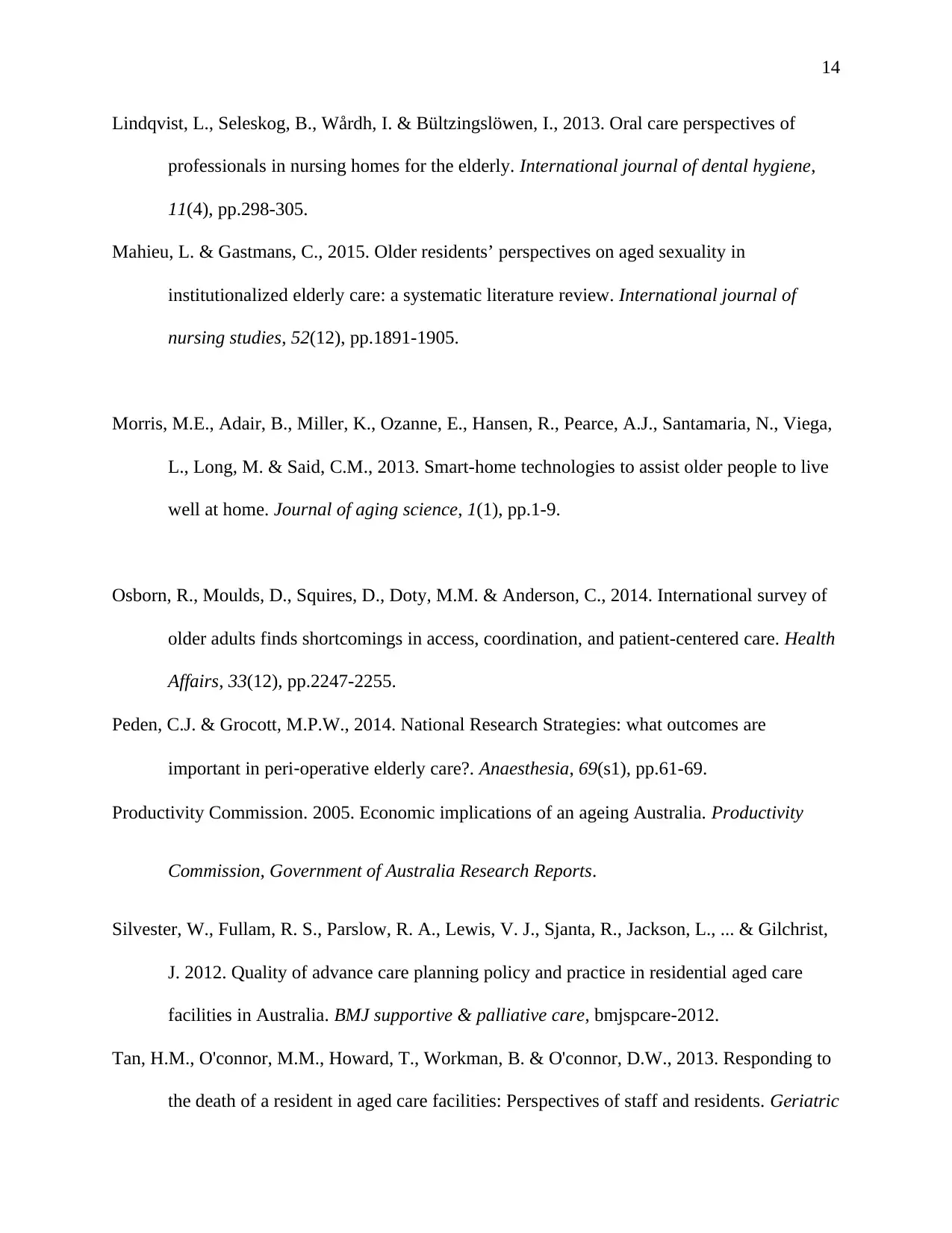
14
Lindqvist, L., Seleskog, B., Wårdh, I. & Bültzingslöwen, I., 2013. Oral care perspectives of
professionals in nursing homes for the elderly. International journal of dental hygiene,
11(4), pp.298-305.
Mahieu, L. & Gastmans, C., 2015. Older residents’ perspectives on aged sexuality in
institutionalized elderly care: a systematic literature review. International journal of
nursing studies, 52(12), pp.1891-1905.
Morris, M.E., Adair, B., Miller, K., Ozanne, E., Hansen, R., Pearce, A.J., Santamaria, N., Viega,
L., Long, M. & Said, C.M., 2013. Smart-home technologies to assist older people to live
well at home. Journal of aging science, 1(1), pp.1-9.
Osborn, R., Moulds, D., Squires, D., Doty, M.M. & Anderson, C., 2014. International survey of
older adults finds shortcomings in access, coordination, and patient-centered care. Health
Affairs, 33(12), pp.2247-2255.
Peden, C.J. & Grocott, M.P.W., 2014. National Research Strategies: what outcomes are
important in peri‐operative elderly care?. Anaesthesia, 69(s1), pp.61-69.
Productivity Commission. 2005. Economic implications of an ageing Australia. Productivity
Commission, Government of Australia Research Reports.
Silvester, W., Fullam, R. S., Parslow, R. A., Lewis, V. J., Sjanta, R., Jackson, L., ... & Gilchrist,
J. 2012. Quality of advance care planning policy and practice in residential aged care
facilities in Australia. BMJ supportive & palliative care, bmjspcare-2012.
Tan, H.M., O'connor, M.M., Howard, T., Workman, B. & O'connor, D.W., 2013. Responding to
the death of a resident in aged care facilities: Perspectives of staff and residents. Geriatric
Lindqvist, L., Seleskog, B., Wårdh, I. & Bültzingslöwen, I., 2013. Oral care perspectives of
professionals in nursing homes for the elderly. International journal of dental hygiene,
11(4), pp.298-305.
Mahieu, L. & Gastmans, C., 2015. Older residents’ perspectives on aged sexuality in
institutionalized elderly care: a systematic literature review. International journal of
nursing studies, 52(12), pp.1891-1905.
Morris, M.E., Adair, B., Miller, K., Ozanne, E., Hansen, R., Pearce, A.J., Santamaria, N., Viega,
L., Long, M. & Said, C.M., 2013. Smart-home technologies to assist older people to live
well at home. Journal of aging science, 1(1), pp.1-9.
Osborn, R., Moulds, D., Squires, D., Doty, M.M. & Anderson, C., 2014. International survey of
older adults finds shortcomings in access, coordination, and patient-centered care. Health
Affairs, 33(12), pp.2247-2255.
Peden, C.J. & Grocott, M.P.W., 2014. National Research Strategies: what outcomes are
important in peri‐operative elderly care?. Anaesthesia, 69(s1), pp.61-69.
Productivity Commission. 2005. Economic implications of an ageing Australia. Productivity
Commission, Government of Australia Research Reports.
Silvester, W., Fullam, R. S., Parslow, R. A., Lewis, V. J., Sjanta, R., Jackson, L., ... & Gilchrist,
J. 2012. Quality of advance care planning policy and practice in residential aged care
facilities in Australia. BMJ supportive & palliative care, bmjspcare-2012.
Tan, H.M., O'connor, M.M., Howard, T., Workman, B. & O'connor, D.W., 2013. Responding to
the death of a resident in aged care facilities: Perspectives of staff and residents. Geriatric
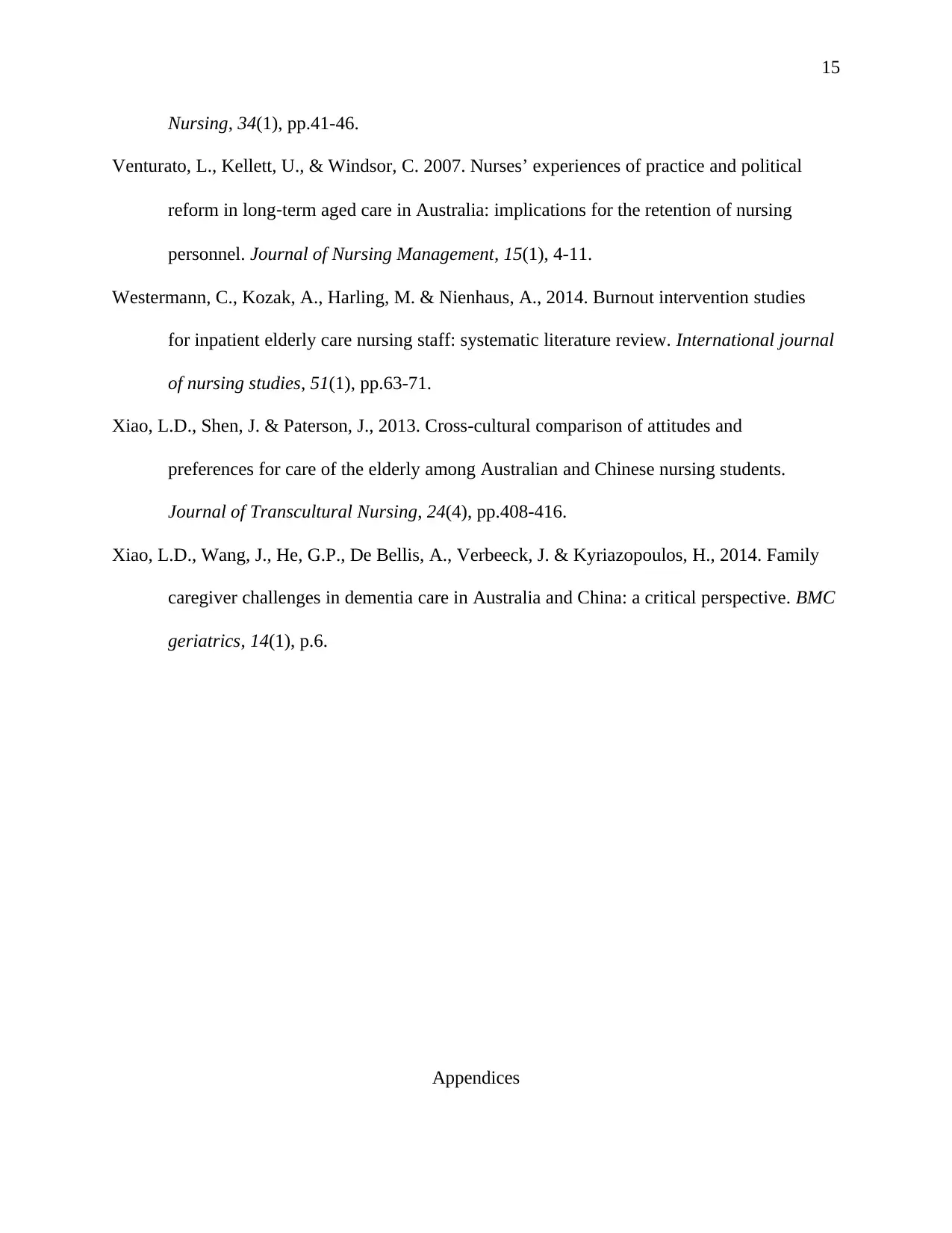
15
Nursing, 34(1), pp.41-46.
Venturato, L., Kellett, U., & Windsor, C. 2007. Nurses’ experiences of practice and political
reform in long‐term aged care in Australia: implications for the retention of nursing
personnel. Journal of Nursing Management, 15(1), 4-11.
Westermann, C., Kozak, A., Harling, M. & Nienhaus, A., 2014. Burnout intervention studies
for inpatient elderly care nursing staff: systematic literature review. International journal
of nursing studies, 51(1), pp.63-71.
Xiao, L.D., Shen, J. & Paterson, J., 2013. Cross-cultural comparison of attitudes and
preferences for care of the elderly among Australian and Chinese nursing students.
Journal of Transcultural Nursing, 24(4), pp.408-416.
Xiao, L.D., Wang, J., He, G.P., De Bellis, A., Verbeeck, J. & Kyriazopoulos, H., 2014. Family
caregiver challenges in dementia care in Australia and China: a critical perspective. BMC
geriatrics, 14(1), p.6.
Appendices
Nursing, 34(1), pp.41-46.
Venturato, L., Kellett, U., & Windsor, C. 2007. Nurses’ experiences of practice and political
reform in long‐term aged care in Australia: implications for the retention of nursing
personnel. Journal of Nursing Management, 15(1), 4-11.
Westermann, C., Kozak, A., Harling, M. & Nienhaus, A., 2014. Burnout intervention studies
for inpatient elderly care nursing staff: systematic literature review. International journal
of nursing studies, 51(1), pp.63-71.
Xiao, L.D., Shen, J. & Paterson, J., 2013. Cross-cultural comparison of attitudes and
preferences for care of the elderly among Australian and Chinese nursing students.
Journal of Transcultural Nursing, 24(4), pp.408-416.
Xiao, L.D., Wang, J., He, G.P., De Bellis, A., Verbeeck, J. & Kyriazopoulos, H., 2014. Family
caregiver challenges in dementia care in Australia and China: a critical perspective. BMC
geriatrics, 14(1), p.6.
Appendices
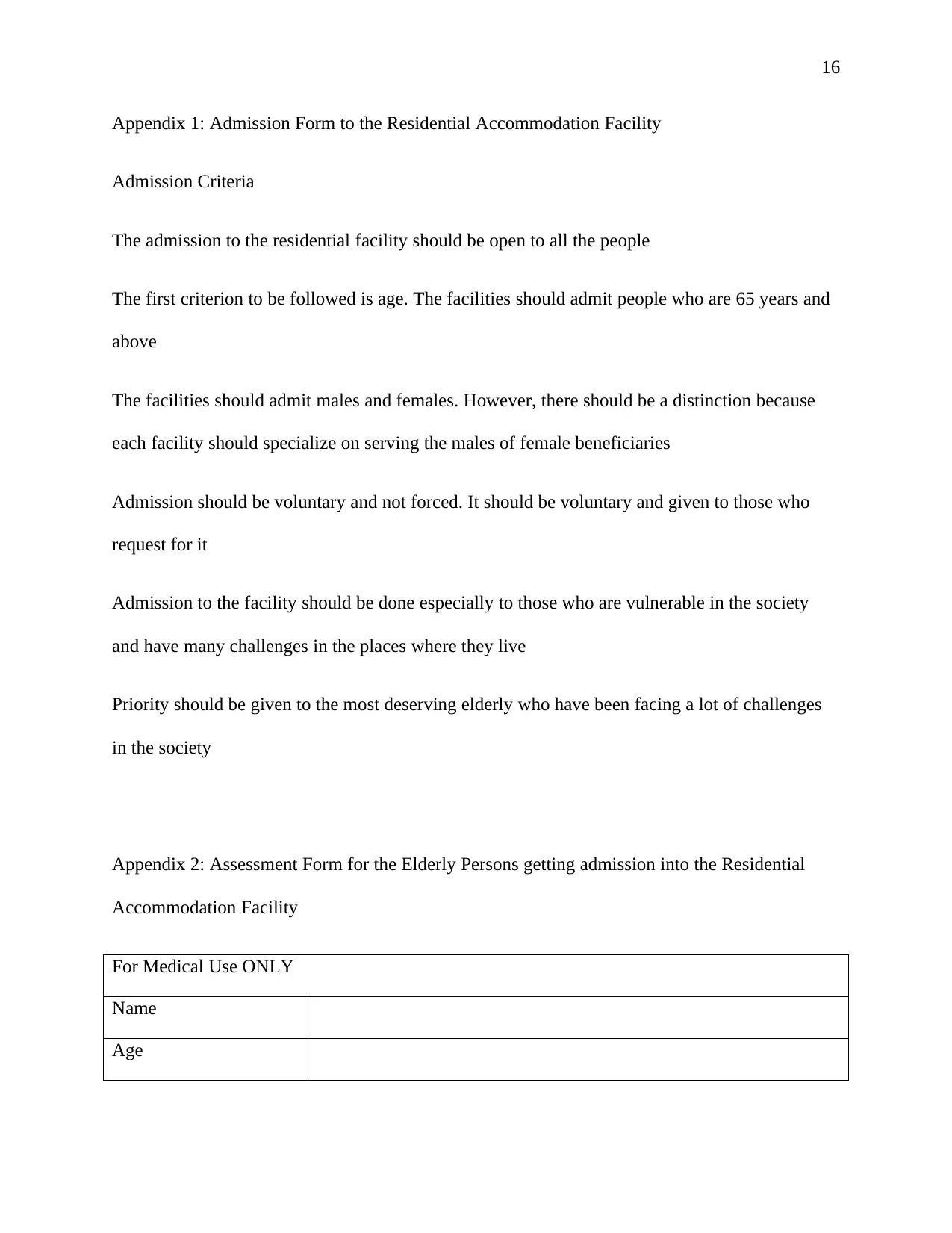
16
Appendix 1: Admission Form to the Residential Accommodation Facility
Admission Criteria
The admission to the residential facility should be open to all the people
The first criterion to be followed is age. The facilities should admit people who are 65 years and
above
The facilities should admit males and females. However, there should be a distinction because
each facility should specialize on serving the males of female beneficiaries
Admission should be voluntary and not forced. It should be voluntary and given to those who
request for it
Admission to the facility should be done especially to those who are vulnerable in the society
and have many challenges in the places where they live
Priority should be given to the most deserving elderly who have been facing a lot of challenges
in the society
Appendix 2: Assessment Form for the Elderly Persons getting admission into the Residential
Accommodation Facility
For Medical Use ONLY
Name
Age
Appendix 1: Admission Form to the Residential Accommodation Facility
Admission Criteria
The admission to the residential facility should be open to all the people
The first criterion to be followed is age. The facilities should admit people who are 65 years and
above
The facilities should admit males and females. However, there should be a distinction because
each facility should specialize on serving the males of female beneficiaries
Admission should be voluntary and not forced. It should be voluntary and given to those who
request for it
Admission to the facility should be done especially to those who are vulnerable in the society
and have many challenges in the places where they live
Priority should be given to the most deserving elderly who have been facing a lot of challenges
in the society
Appendix 2: Assessment Form for the Elderly Persons getting admission into the Residential
Accommodation Facility
For Medical Use ONLY
Name
Age
Secure Best Marks with AI Grader
Need help grading? Try our AI Grader for instant feedback on your assignments.
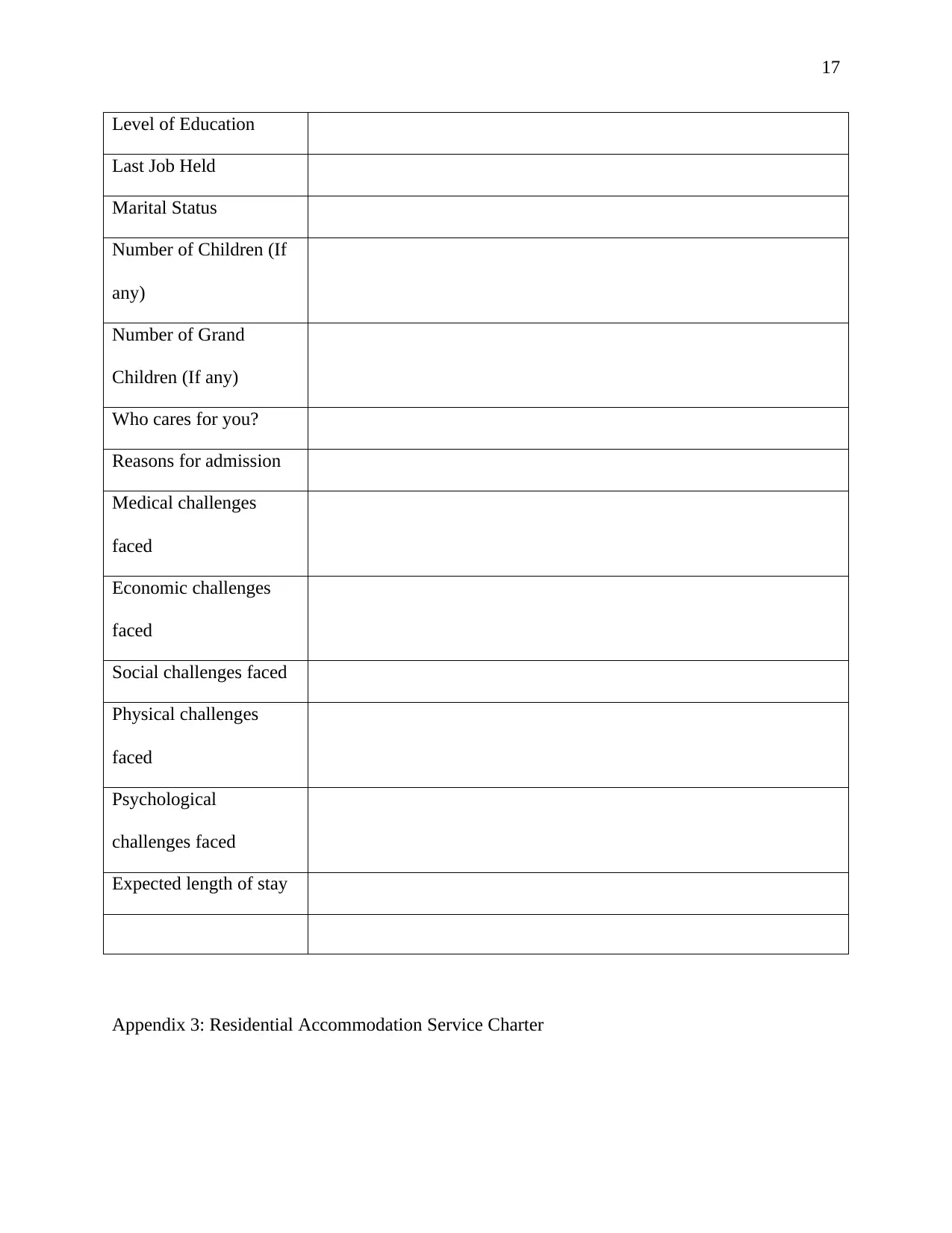
17
Level of Education
Last Job Held
Marital Status
Number of Children (If
any)
Number of Grand
Children (If any)
Who cares for you?
Reasons for admission
Medical challenges
faced
Economic challenges
faced
Social challenges faced
Physical challenges
faced
Psychological
challenges faced
Expected length of stay
Appendix 3: Residential Accommodation Service Charter
Level of Education
Last Job Held
Marital Status
Number of Children (If
any)
Number of Grand
Children (If any)
Who cares for you?
Reasons for admission
Medical challenges
faced
Economic challenges
faced
Social challenges faced
Physical challenges
faced
Psychological
challenges faced
Expected length of stay
Appendix 3: Residential Accommodation Service Charter
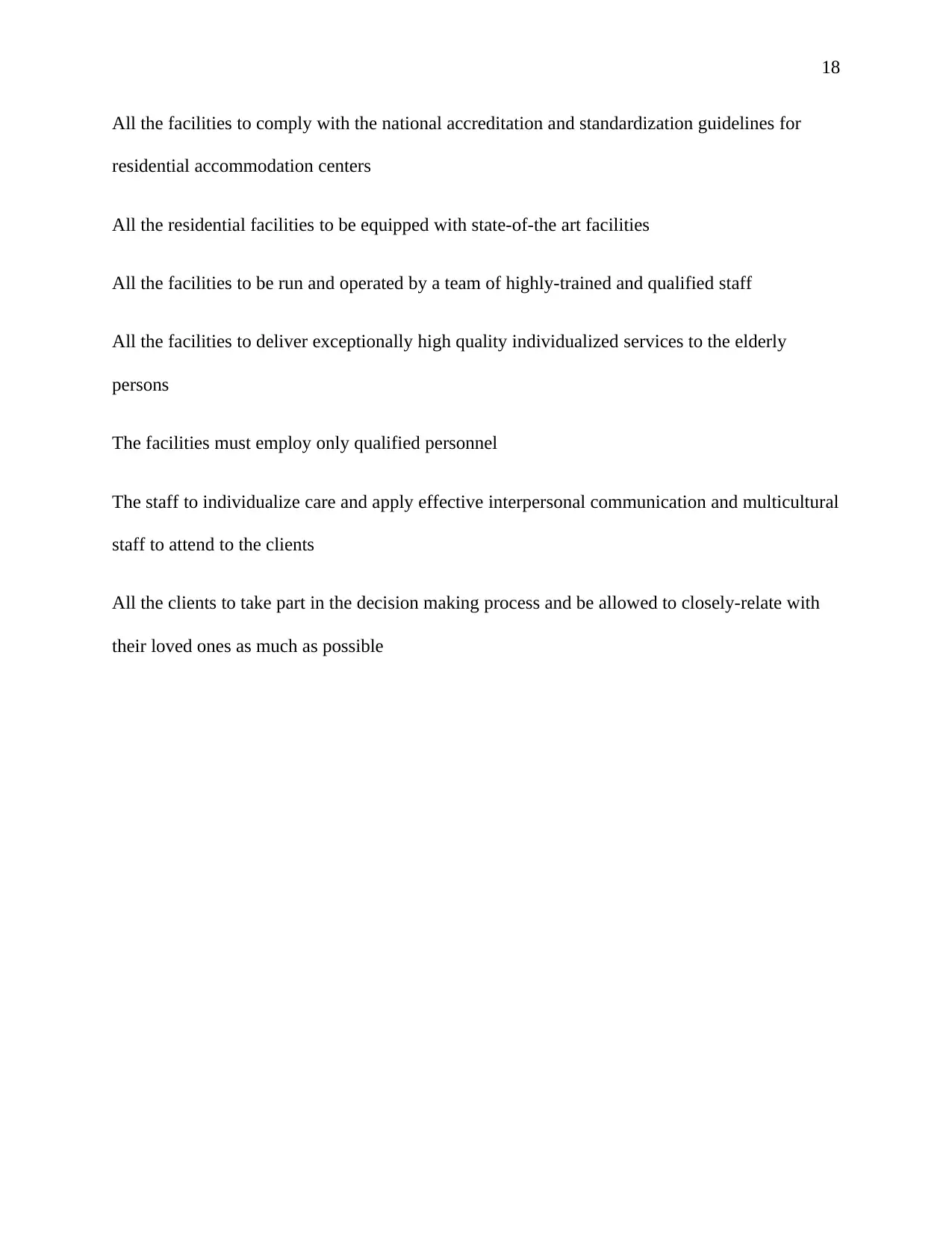
18
All the facilities to comply with the national accreditation and standardization guidelines for
residential accommodation centers
All the residential facilities to be equipped with state-of-the art facilities
All the facilities to be run and operated by a team of highly-trained and qualified staff
All the facilities to deliver exceptionally high quality individualized services to the elderly
persons
The facilities must employ only qualified personnel
The staff to individualize care and apply effective interpersonal communication and multicultural
staff to attend to the clients
All the clients to take part in the decision making process and be allowed to closely-relate with
their loved ones as much as possible
All the facilities to comply with the national accreditation and standardization guidelines for
residential accommodation centers
All the residential facilities to be equipped with state-of-the art facilities
All the facilities to be run and operated by a team of highly-trained and qualified staff
All the facilities to deliver exceptionally high quality individualized services to the elderly
persons
The facilities must employ only qualified personnel
The staff to individualize care and apply effective interpersonal communication and multicultural
staff to attend to the clients
All the clients to take part in the decision making process and be allowed to closely-relate with
their loved ones as much as possible
1 out of 18
Your All-in-One AI-Powered Toolkit for Academic Success.
+13062052269
info@desklib.com
Available 24*7 on WhatsApp / Email
![[object Object]](/_next/static/media/star-bottom.7253800d.svg)
Unlock your academic potential
© 2024 | Zucol Services PVT LTD | All rights reserved.
